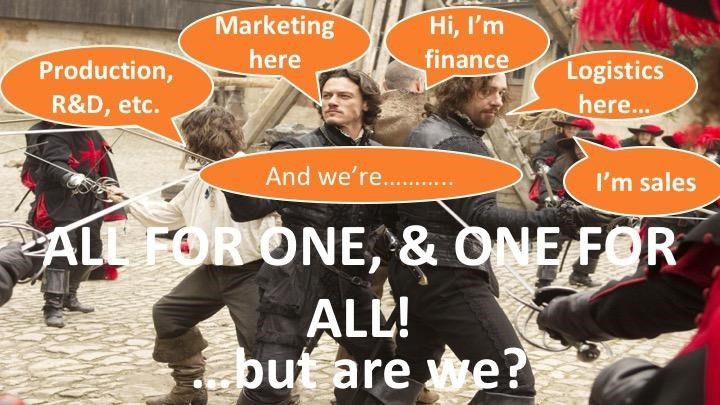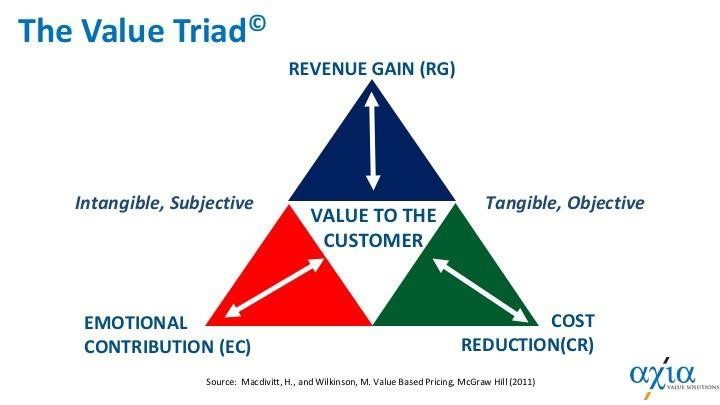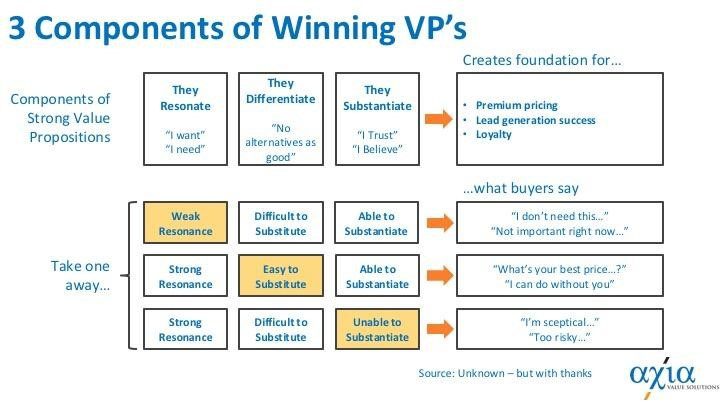What sometimes seems to be forgotten is that the pursuit of a value orientation to the business involves a lot more than just the sales force. Selling on value involves organisational change, not just a sales force training workshop. The sales force can understand and promise great value, but it is the organisation in totality that will actually deliver that value. A car’s flashy exterior might look great, but when you hit the pedal, does the car perform? The focus too often is on the front facing activity without thinking about what needs to change under the bonnet, or as those Americans amongst you insist on calling it, the hood! Then as value delivery begins to suffer everyone starts to lose faith. A recent client of ours summed this up perfectly: “We are at our best when we are all aligned around customer value”.
In our experience, it is unusual that a business is completely aligned around customer value, but if we agree that it really is important for businesses that strive to deliver real customer value, why is it so difficult to achieve?
 Before discussing the Seven Challenges of Value, let’s begin with the 3 Basic Business Challenges (BBC’s) of Value, the things that we are all striving to do: Understand Value, Create Value, and Deliver Value. But we’re striving for something more specific. Our real focus is not just on value, it’s on Customer Value. Our customers define customer value, not us, so we have to focus on: Understanding Customer Value, Creating Customer Value, and Delivering Customer Value. Understanding, creating and delivering customer value is a team game. That means that your business has a clear, consistent value message for its customers. Sales, marketing, production, R&D, finance, logistics, pricing are, “All for one, and one for all!”
Before discussing the Seven Challenges of Value, let’s begin with the 3 Basic Business Challenges (BBC’s) of Value, the things that we are all striving to do: Understand Value, Create Value, and Deliver Value. But we’re striving for something more specific. Our real focus is not just on value, it’s on Customer Value. Our customers define customer value, not us, so we have to focus on: Understanding Customer Value, Creating Customer Value, and Delivering Customer Value. Understanding, creating and delivering customer value is a team game. That means that your business has a clear, consistent value message for its customers. Sales, marketing, production, R&D, finance, logistics, pricing are, “All for one, and one for all!”
What is critical in any organization that purports to “sell on value” is that everyone is absolutely clear on:
“What is my role in understanding, creating, and delivering customer value?”
If they are not, it is not one business, one voice. I love the story about John Kennedy who, after delivering his vision of putting a man on the moon and bringing him safely back to earth, made a visit to Cape Canaveral. He came across a janitor and asked him what his job was. “My job is putting a man on the moon.” Our job should be a lot simpler than that, and it is made a lot simpler if everyone understands their role.
So, with the 3 BBC’s of understanding, creating and delivering customer value in place, let’s turn to the 7 challenges of value.
Challenge # 1: Understand what value is. Let’s break this challenge down into three parts:
- what value is as a concept,
- what value means to our customers, on the basis that our understanding of value and theirs might differ,
- and finally making sure that everyone in our business understands value in the same way.
Value as a concept only began to crystallise during my experiences at a conference in Copenhagen a few years ago. It started with the creation of our definition of value: Value is a mystery. Given that customers define value, not us, until we truly understand the customer’s perception of value that is what it is: A Mystery. However, this is not necessarily helpful in understanding what value means to our customer, so we developed the Value Triad© to give us structure on which to “hang” value and help in solving the value mystery.
 Revenue Gain – how can our product or service help our customer improve their revenues?
Revenue Gain – how can our product or service help our customer improve their revenues?
Cost Reduction – how can our product or service help our customer reduce their costs?
These are both tangible, objective measures against which a real monetary value can be calculated. However, if you don’t know how your customer generates revenue, or you don’t know how they incur costs, this is going to be a good deal more difficult. If you truly know the answer to this and your competitors do not, you are at a potentially significant advantage.
The final component of the Triad is Emotional Contribution. This component is much more intangible and subjective, but as long as people make decisions, it will remain important. This is the value of trust, confidence, the brand, the relationships, ease of doing business, cultural fit, just “feeling good” about doing business with you. Don’t underestimate its value if you have it, and don’t underestimate it if you don’t!
Understanding the elements of the Value Triad© allows us to solve the value mystery with each customer, but we also need to make sure that everyone in our business understands value as a concept, and what it means to each customer. If they don’t how will they understand their role of creating and delivering customer value?
Challenge #2: Recognise that customer’s value perceptions are constantly changing. Budget impacts, changing internal priorities, personnel turnover, political considerations, regulatory issues and more can influence and change value perceptions. It’s crucial to keep close and up to date with what is happening in the customer and in their thinking.
Challenge #3: Identify and talk to people who care the most about your value. The bottom line is that you can’t sell value to people, or organisations, that don’t care about value. Equally, as today’s decision making seems to become increasingly complex, we need to have won over those people who can really see and appreciate the value we can deliver. These people will then act as our evangelists inside the organisation. For most of us as salespeople, when the decision to buy or not buy from us is made, we’re not there. We want to be sure that our message and value is communicated effectively internally by understanding not just who but how the decision will be made. And making sure that our “internal evangelists” are well prepared to “sell” on our behalf.
Challenge #4: Differentiate your offering. Being different is not differentiation. You have to be different in ways the customer values – and you need to calculate that value.
Challenge #5: Communicate your value. We have already mentioned the importance of monetising value. Customers don’t want vague promises, they want firm commitments. They don’t want to know you can save them money, make them money. They want to know how much and by when. The Leverage Point tools help hugely in this. Creating a powerful and persuasive value proposition is critical. But I think there are two value propositions.
The first is at the beginning of the sales process. This should answer the question “Why should I talk to you?” The second, monetised, focused value proposition is at the end and answers the question “Why should we choose you?” Joining the two together is the value selling process which encompasses Value Discovery – solving the value mystery, and Value Demonstration. Building a powerful, persuasive final value proposition is important and should have three key components:
- They resonate: The customer can clearly see your solution addresses their issues
- They differentiate: I can see that you do things that I cannot get elsewhere or not as well elsewhere
- They substantiate: Not only do you talk a good story but you can prove that you can do the things you say you can do
If these three components are all in place it leads to opportunities for premium/value pricing, to lead generation success and to customer loyalty. However, take just one of the components away and the strength of the proposition is potentially fatally impaired.

No resonance – “I don’t need this.” “Not important to me right now.”
No differentiation – you’re easy to substitute leading to “What’s your best price?” “I can do without you.”
No substantiation – leads to no trust and high perceived risk.
Challenge #6: Capturing your value through price. Again, the Leverage Point tool is perfect for helping to calculate prices that are based on value delivery. These are at the heart of your value proposition and open up what we call “The Negotiation Corridor” – the difference between the maximum price you could charge given your value delivery, and the price the customer is currently paying or the price they would pay if they didn’t choose your solution. All your work up to now has been designed to help you make that Negotiation Corridor as wide as possible by truly understanding the things that are important to your customer.
Remember, Price is NOT the reason customers don’t buy, they don’t buy because they don’t see the value in our offer. Now that we understand the things they truly value and have differentiated and monetised our solution this should be much less of an issue.
Challenge #7: Deliver your Value. And this takes us right back to the beginning. Does everyone in the organisation really understand their role in understanding, creating and delivering customer value to this customer? Assuming they do – and that is some assumption! – the next task is exactly that – delivering and measuring the value you promised. So, you need to measure your value and your performance.
Make sure the customer is getting the value you promised. If they are, constantly remind them – because customers have this great ability to forget things like that. If they aren’t, address the issues and put things right because customers have a great ability to remember things like that!
Finally, identify opportunities for creating and delivering even more value for the customer by understanding them in ever more detail. Because understanding leads to opportunities.
To learn more about Axia Value Solutions click here.

